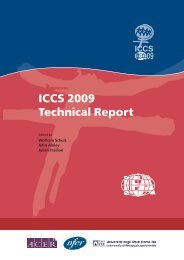Teacher Education and Development Study in Mathematics - IEA
Teacher Education and Development Study in Mathematics - IEA
Teacher Education and Development Study in Mathematics - IEA
Create successful ePaper yourself
Turn your PDF publications into a flip-book with our unique Google optimized e-Paper software.
PART 1: SALARY RELATIVITIES<br />
33<br />
Table 3 conta<strong>in</strong>s a number of surprises. For example, Chile <strong>and</strong> Mexico, both middle<strong>in</strong>come<br />
countries with very unequal <strong>in</strong>come distributions, pay relatively high salaries to<br />
teachers, whereas several developed countries, such as France, Spa<strong>in</strong>, <strong>and</strong> Germany, with<br />
relatively equal <strong>in</strong>come distributions do not. Another surprise is the very low relative<br />
pay of teachers <strong>in</strong> the United States.<br />
We can identify, from the table, three sets of countries <strong>in</strong> the sample of 20. The first set<br />
comprises those countries that pay relatively high salaries to teachers (90% or more of<br />
a scientist’s salary). The second set <strong>in</strong>cludes those countries that pay teachers between<br />
80% <strong>and</strong> 90% of a scientist’s salary. The third <strong>in</strong>cludes those countries that pay relatively<br />
low salaries to teachers (< 80% of a scientist’s salary).<br />
The first (high-pay<strong>in</strong>g) group <strong>in</strong>cludes Chile, Ch<strong>in</strong>ese Taipei, F<strong>in</strong>l<strong>and</strong>, Hong Kong,<br />
Korea, S<strong>in</strong>gapore, <strong>and</strong> the United K<strong>in</strong>gdom. In Mexico, salaries of female teachers are<br />
high relative to those of female scientists. If we assume that most teachers <strong>in</strong> F<strong>in</strong>l<strong>and</strong><br />
have Master’s degrees, F<strong>in</strong>l<strong>and</strong> falls <strong>in</strong>to the middle-pay<strong>in</strong>g group because F<strong>in</strong>nish<br />
teachers would be compared to higher-paid scientists with Master’s degrees.<br />
Table 3: <strong>Teacher</strong>/Scientist Earn<strong>in</strong>gs Ratios for Bachelor’s Graduates, by Gender, Male/Female Scientist<br />
Earn<strong>in</strong>gs Ratio, GDP per Capita, <strong>and</strong> G<strong>in</strong>i Coefficients, by Country, early 2000s<br />
Country Male Female Male/Female GDP per Capita G<strong>in</strong>i Net<br />
<strong>Teacher</strong>/ <strong>Teacher</strong>/ Scientist (2000 PPP$) Coefficient Secondary<br />
Scientist Scientist Salary Ratio (x 100) Enrollment<br />
Salary Ratio Salary Ratio Ratio (2004)<br />
Australia 2001 0.77 0.84 1.22 26,181 35.2 85<br />
Botswana 2002 0.60 0.88 1.76 7,702 56.0 60<br />
Bulgaria 2001 0.55 0.81 1.90 6,229 31.9 88<br />
Chile 2003 0.93 0.97 1.10 9,197 57.5 70<br />
Ch<strong>in</strong>ese Taipei 2004 1.04 0.98 1.03 25,000 30.8 88<br />
F<strong>in</strong>l<strong>and</strong> 2004 0.90 0.90 1.11 25,141 25.6 94<br />
France 2002 0.70 0.75 1.09 25,318 32.7 96<br />
Germany 2000 0.79 0.85 1.14 26,075 38.2 93<br />
Hong Kong SAR 2001 1.14 1.25 1.21 25,784 43.4 78<br />
Italy 2004 0.88 0.89 1.50 24,936 36.0 91<br />
Korea 2004 0.99 0.91 0.97 15,202 31.6 88<br />
Mexico 2004 0.78 1.07 1.58 8,920 55.0 64<br />
Norway 2005 a 0.82 0.90 1.16 35,132 25.8 96<br />
Philipp<strong>in</strong>es 2006 0.74 0.85 1.16 3,984 46.1 61<br />
S<strong>in</strong>gapore 2004 0.94 0.94 1.05 23,494 42.5 88<br />
Spa<strong>in</strong> 2002 0.79 0.83 1.16 19,969 32.5 97<br />
Switzerl<strong>and</strong> 2004 0.86 0.89 1.09 28,526 33.1 83<br />
Thail<strong>and</strong> 2005 0.63 0.67 1.12 6,350 43.2 57<br />
United K<strong>in</strong>gdom 2005 1.22 1.19 1.05 24,675 36.0 95<br />
United States 2000 0.64 0.74 1.21 34,134 40.8 89<br />
Note: a For Norway, the salary ratio is estimated for those <strong>in</strong>dividuals 30 to 39 years of age <strong>and</strong> 40 to 49 years of age, with both<br />
long- <strong>and</strong> short-course degrees weighted by the number of teachers <strong>and</strong> scientists <strong>in</strong> the sample with each type of degree. Given<br />
differences <strong>in</strong> the number of years of education completed by teachers <strong>and</strong> scientists with each type of degree, this estimate<br />
provides a more accurate one for the salary ratio.<br />
Source: Salary ratios—salary studies <strong>in</strong> this book; GDP per capita, G<strong>in</strong>i coefficients, <strong>and</strong> net enrollment rate—World Bank<br />
(2005). Salary ratios are estimated for the three lowest age groups <strong>and</strong> then averaged.

















